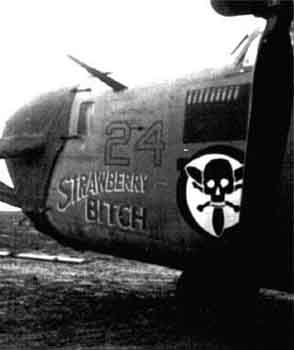Bomber's Pin-Up Beer: 1995
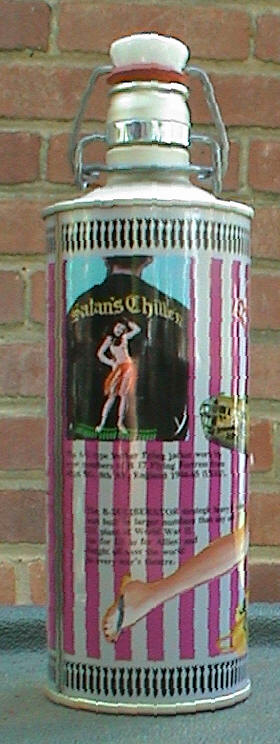 |
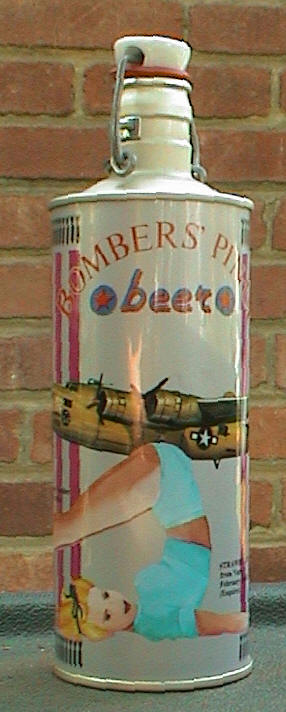 |
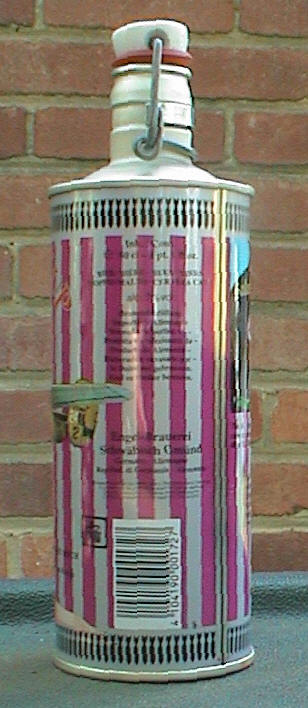 |
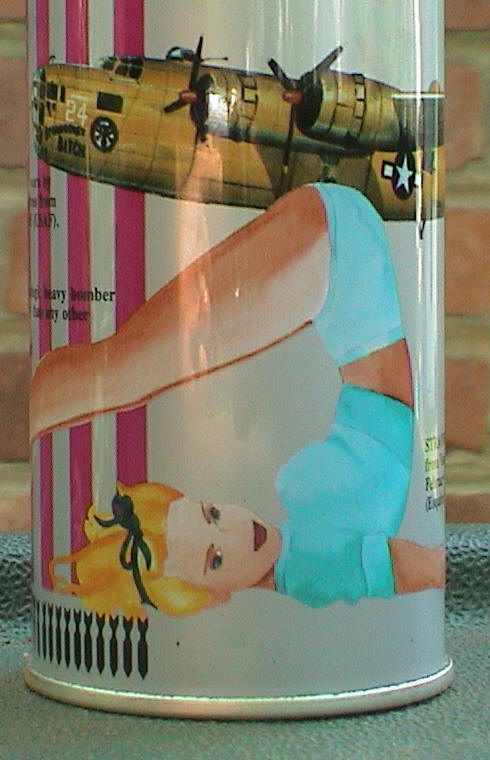 |
| Bombers' Pinup Beer "Strawberry Bitch." Made by Engel-Brauerei, a German brewery. |
The can features a World War II B-24 "Liberator" bomber on it. The aircraft on the can is a real plane, nicknamed "Strawberry Bitch" which served in World War II. It was restored and flown to the U.S. Air Force Museum in May 1959 where it now resides. I'm from Dayton and visited the museum many times. The B-24 was always one of my "favorite" World War II planes and this was always my favorite plane at the museum. So when this can was issued I grabbed it for my collection. For some reason the Vargas girl on the can is NOT the same girl that appears on the actual plane! The girl on the can was Esquire's Vargas Girl for February 1944. I have not yet discovered just who inspired the nose art girl on the real "Strawberry Bitch."
Strawberry Bitch
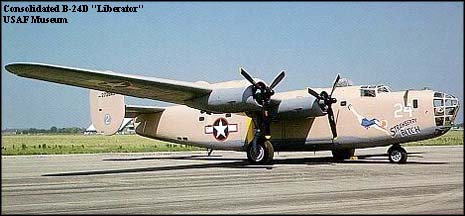 B-24 "Strawberry Bitch." Photo courtesy of the USAF.
B-24 "Strawberry Bitch." Photo courtesy of the USAF.
The B-24D-160-CO (S/N 42-72843) "Strawberry Bitch" flew combat missions from North Africa in 1943-44 with the 512th Bomb Squadron. The aircraft was named, in part, because of the pinkish-tinted paint. It did NOT take part, however, in one of the most famous missions, the huge raid on the oil refinery complex at Ploesti, Romania on August 1, 1943. However, other planes in the same group apparently did take part. Ploesti was the largest allied bombing raid of the war up to that point. The oil field complex was a crucial target as it supplied up to one third of Germany's oil for the war (other estimates say up to 60%) Ploesti had seven major refineries along with storage tanks covering nineteen square miles. The flight crews practiced on a full-scale replica of the refineries in the Libyan desert. They ran low-level practice runs to work out a precise timetable attack which required a difficult approach through the Carpathian Mountains. One hundred seventy-seven (177) B-24's, of the IX Bomber Command (including B-24's on loan from the Eighth Air Force) participated. The operation, code named TIDALWAVE was very costly. Some of the groups, including the 376 Bomber Group (which included Strawberry Bitch's squadron) made a wrong turn and so hit targets of opportunity at the Ploesti complex. German radar had picked up the planes on approach so they lost the hoped for element of surprise. Some planes flew so low they were damaged by explosions from the fuse-delay bombs dropped by the aircraft in front of them. Fifty-four (54) B-24s and 532 airmen were lost and fifty-three (53) other planes were severely damaged. They inflicted severe damage on their targets but the losses were so heavy that the raid could not be repeated and the damage was repaired. Five Medals of Honors were awarded for this mission.
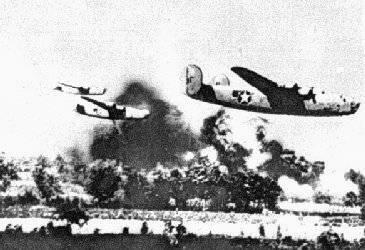 |
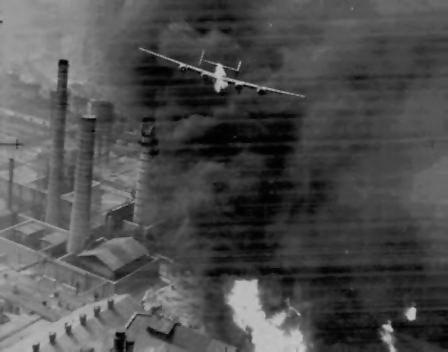 |
-24s fly low over Ploesti. Photo USAF. |
Another B-24, note how low they flew over Ploesti. Photo USAF. |
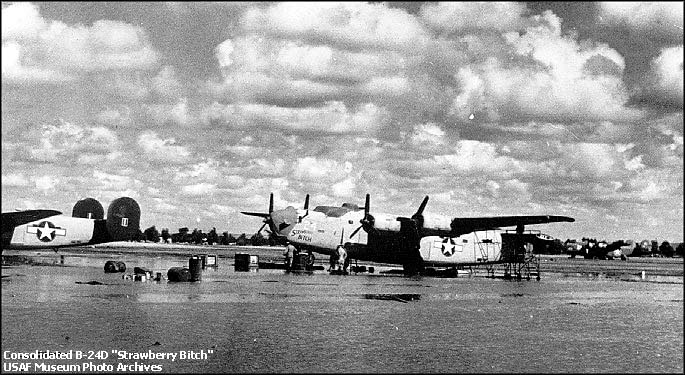
"Strawberry Bitch" undergoing maintenance in 1943 at the 58th Service Squadron depot.
Nose Art
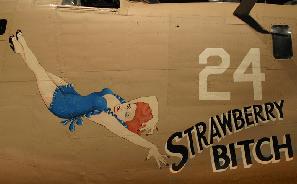 The real Strawberry Bitch nose art, click to see larger.
The real Strawberry Bitch nose art, click to see larger. Photo used with permission of Bill Storage and Laura Maish at bstorage.com.
As early as World War I pilots and air crews painted squadron insignia on aircraft, the most famous perhaps being the “Hat in the Ring.” In World War II, however, this popular art form jumped ahead by leaps and bounds. Cartoon figures, especially from Disney, movie stars and, most famously, pin up girls began decorating aircraft of every type. While never officially sanctioned by the military, such art was given a fairly free reign as a morale-booster. Many of the pilots and crew were barely out of their teens, a prime time to enjoy pinups of pretty girls, and the art provided a reminder of home as well as some fun and humor in a difficult situation. Of course people tend to anthropomorphize machines anyway. The nose art gave the plane a “personality” as well as a name. Strawberry Bitch is just one example.
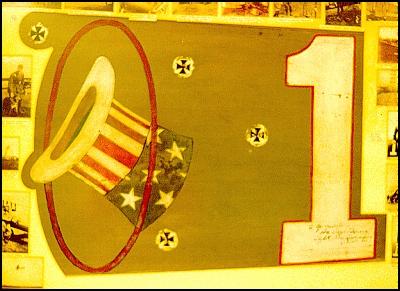 The "Hat in the Ring" aircraft art from World War I, 1917-1918. Photo USAF.
The "Hat in the Ring" aircraft art from World War I, 1917-1918. Photo USAF.At any rate, recognizing the effect the art had on morale Army Air Force Regulation 35-22, of August 1944, authorized decorating any air force equipment with individual designs. The Navy and the Marines were not as accepting as the Army, but they did allow some nose markings. According to one study, the artwork tended to get more daring, more risqué, the further one was from the US, and from headquarters. Artwork in the Pacific, for example, tended to feature more nude pinups than seen in Europe. There is a story, perhaps apocryphal, that the young woman on the nose art was naked originally, but that the clothes were painted on when it was restored. This may be possible as some of the other aircraft in the 376th Heavy Bomber Group did have nudes as nose art.
The pinups came from several sources. Esquire Magazine, with its Alberto Vargas gatefold was a prime source as were George Petty’s images. Milt Canniff’s characters such as Dragon Lady or Miss Lace were also popular as was Moonbeam McSwine from Lil Abner. Real life figures, such as Hollywood stars like Rita Hayworth also provide inspiration. Less risqué images were taken from Disney and other cartoons. Disney’s staff designed over 1,200 unit insignias free of charge by war’s end.
It’s the pinups that are remembered 60 years later, however, not the Disney cartoon nose art. They provided some character to the aircraft as well as a morale boost. “Strawberry Bitch” survives as a good example of this folk art for future generations.
Ghost Stories
There are several ghost stories about this aircraft. One story says that the plane is haunted, that the belly guns sometimes rattle, and that a custodian once felt someone strike him in the face. Another site reports that strange lights have been seen in the plane at night. There are a number of ghost stories associated with the Air Force museum, usually attached to planes in which somebody was killed during a war.
Video
Here is some video of the real plane.
B-24 Specifications
Span: 110 ft. 0 in.
Length: 66 ft. 4 in.
Height: 17 ft. 11 in.
Weight: 56,000 lbs. loaded
Armament: Eleven .50-cal. machine guns [nose, left & right cheek, top turret (2), ball turret (2), left and right waist and tail (2)] plus a normal maximum load of 8,000 lbs. of bombs
Engines: Four Pratt & Whitney R-1830s of 1,200 hp. ea.
Cost: $336,000
Serial Number: 42-72843
PERFORMANCE
Maximum speed: 303 mph.
Cruising speed: 175 mph.
Range: 2,850 miles
Service Ceiling: 28,000 ft.
Famous B-24 Crewmembers
Among the famous men who flew in B-24s are...
George McGovern (who was awarded the Distinguished Flying Cross)
Lloyd Bentson
Stewart Udall
Jimmy Stewart
Walter Matthau
Russell Johnson (the Professor on Gilligan's Island!)
|
The other side of "Strawberry Bitch's nose" 1943-44.
Photo: USAF.
Sources Used:
Thank you to the 376th Bomb Group (H) site on Yahoo for their help!
B-24 Best Web has lots on info on the Liberator!
Skylighter.com has some more photos, including one of the crew.
More Ghost Stories about the Strawberry Bitch.
Bstorage.com, a site owned by two professional photographers, has a nice gallery of the Air Force Museum.
University of Kansas Vargas Exhibit
The University of Arizona has a good short history of nose art.
512th Bomb Squadron History
376th Heavy Bomber Group Site.
Want to see a real B-24 in person? Go to the 5th AAF 43rd Bomb Group (H) site. They have a list of surviving B-24s, including some which are still flyable.

